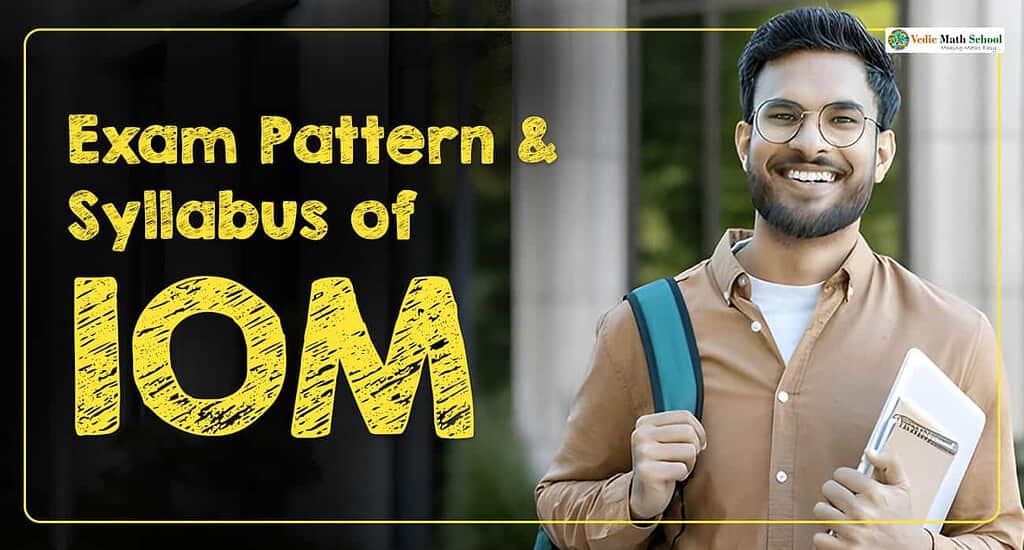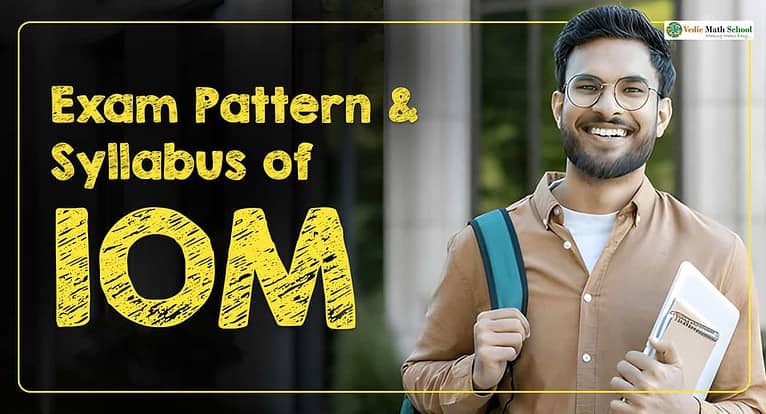
Silver iOM Exam Pattern
If you participate in International Olympiads of Mathematics it will be organized in your schools during the school hours. The iOM exam pattern is crafted to assess your mathematical skills through a variety of question types. The exam is designed to challenge you while aligning with your school curriculum. To learn more about the iOM Olympiad, you can visit the following link:
- iOM Exam Registration
- iOM Exam Eligibility
- IMO Exam Syllabus
Structure of the IOM Olympiad
The structure of the Olympiad stands as the following:
There will be a different question paper for each class and different question papers set for different days. All the questions are objective type with no negative marking for wrong answers.
Stages of IOM
The IOM usually consists of three stages, where you from grades 1 to 12 participate in the exam.
Structure of the iOM Olympiad
- Grade-Specific Papers: The structure of the exam varies by grade. Lower grades have simpler questions, focusing on basic arithmetic and fundamental concepts, while higher grades encounter more complex problems involving algebra, geometry, and higher-level mathematical reasoning.
- MultipleChoice Questions (MCQs): The majority of the questions in the IOM are in multiple-choice format, where you must select the correct answer from the given options.
iOM Olympiad Sections:
The exam is typically divided into sections, such as:
- Mathematical Reasoning
- Logical Reasoning
- Everyday Mathematics
- Scholars Zone (for advanced levels)
Types of Questions
The questions in the iOM are predominantly multiple choice, designed to test a student’s conceptual understanding and application of mathematical principles. The questions are not just about rote memorization; they challenge you to apply your knowledge in new and creative ways.
Recommended Study Material
To prepare effectively for the IOM, you are advised to use the following materials:
- School Textbooks: You should study textbooks prescribed by schools as they are your primary resources since the IOM syllabus aligns with the school curriculum.
- Vedic Maths School’s Study Material: The SilverZone Foundation provides specific study materials tailored to the IOM syllabus. These resources include practice books, guides, and previous year’s papers.
- Mathematical Olympiad Workbooks: These workbooks are specifically designed to prepare you for mathematical competitions, providing practice questions and explanations.
Sample Papers
Sample papers for the iOM can be downloaded from our website. These papers are an excellent way for you to familiarize yourself with the exam format and types of questions. Practising with sample papers helps you manage your time better and identify areas where they need improvement.
| Classes | Class 1 & 2 | Class 3 to 5 | Class 6 to 8 | Class 9 to 12 |
| No. of Questions | 25 | 30 | 35 | 40 |
| Duration of Time | 40 | 50 | 50 | 50 |
| Total Marks | 100 | 100 | 100 | 100 |
Each question paper for each grade has three sections:
(i) Section-1: Mathematics
(ii) Section-2: Reasoning and Aptitude
(iii)Section-3: Scholar’s Zone
Silver IOM Exam Syllabus
| Class | 1 |
| 1. Counting numbers 2. Operation on numbers 3. Time and calendar 4. Money 5. Measurements 6. Geometrical Shapes 7. Reasoning and aptitude | |
| Class | 2 |
| 1. Counting Numbers: Ones, Tens, Hundreds, and Thousands 2. Operations on Numbers: Addition, Subtraction, Multiplication, Division, Comparison 3. Time and Calendar 4. Measurements 5. Money 6. Geometrical Shapes 7. Reasoning and Aptitude | |
| Class | III |
| 1. Numbers and their Operations: Number Sense and Numeration, Addition and Subtraction, Multiplication and Division 2. Everyday Mathematics: Time and Calendar, Money, Unitary Method 3. Fractions 4. Measurements 5. Geometrical Shapes 6. Data Handling 7. Reasoning and Aptitude | |
| Class | IV |
| 1. Numbers and their operations: Number Sense and Numeration, Roman Numerals, Addition & Subtraction, Multiplication & Division 2. Fractions And Decimals 3. Everyday Mathematics: Money, Unitary method 4. Geometrical Shapes 5. Perimeter and Area 6. Data Handling 7. Reasoning and Aptitude | |
| Class | V |
| 1. Numbers in Operation: Number Sense and Numeration, Numbers in Operation, Factors, and Multiples 2. Factors and Multiples 3. Everyday Mathematics: Percentage, Ratio, and Proportion/ Time and Distance 4. Geometry and Measurements 5. Introduction to Algebra6. Data Handling 7. Reasoning and Aptitude | |
| Class | VI |
| 1. Numbers and their Operations, Factors, and Multiples 2. Fractions and Decimals 3. Mensuration and Geometry 4. Introduction to sets 5. Data Handling 6. Reasoning and Aptitude | |
| Class | VII |
| 1. Numbers and their Operations: Fractions and Decimals, Rational Numbers, Exponents, and Power 2. Algebraic Expressions, Linear Equation 3. Everyday Mathematics: Ratio and Proportion, Percentage, Profit and Loss, Simple and Compound Interests 4. Geometry and Mensuration: Lines and Angles, Triangles, Mensuration 5. Data Handling 6. Sets7. Reasoning and Aptitude | |
| Class | VIII |
| 1. Number Systems and Operations: Number Systems, Powers and exponents, Square and Square Root, Cube and Cube Root 2. Algebra and Geometry: Algebraic Expression, Factorization, Linear Equation, Convex, and Concave polygon 3. Comparing Quantities: Direct and inverse proportions, Time and Work, Percentage, Profit and Loss, Compound Interest and Simple Interest 4. Mensuration: Surface area and volume of Cube, Cuboid, and Cylinder 5. Data Handling: Frequency distribution, Line graph, Bar graph, Histogram, and Pie Chart 6. Operations on Sets and Venn Diagram 7. Reasoning and Aptitude | |
| Class | IX |
| 1. Real Numbers: Irrational Numbers, Real numbers and their Decimal expansions, Operation on real Numbers, Laws of Exponents for real numbers2. Algebra & Co-ordinate geometry: Polynomials, Logarithms, Linear equation in two variables, Coordinate geometry 3. Geometry: Lines and Angles, Triangles, Quadrilaterals, Areas of Parallelograms and Triangles, Circles 4. Trigonometry ratios and identities 5. Statistics and Probability: Measures of Dispersion, Mean, Median and Mode, Probability of an Event 6. Applied Mathematics: Mensuration and Word Problems Based On Mathematics 7. Reasoning and aptitude | |
| Class | X |
| 1. Number System, Sequence, and Series: Decimal Expansion of Rational numbers, Arithmetic Progression, Geometric Progression, Harmonic Progression 2. Algebra and Coordinate Geometry: Polynomials, Pair of Linear equations in two variables, Quadratic equation, Coordinate geometry 3. Geometry: Similar figures, Similarity of Triangles, Areas Of Similar triangles, Circles, Tangent to a circle4. Trigonometry, Height, and Distance 5. Statistics and Probability: Mean, Mode and Median of Grouped Data, Mean deviation about mean, Mean deviation about Median, Standard Deviation and Variance, Probability of Events 6. Surface area and Volume 7. Reasoning and Aptitude | |
| Class | XI |
| 1. Sets & Functions: Sets, Relations and Functions, Trigonometric functions 2. Algebra: Mathematical Induction, Complex number, Sequence and series, Permutation and combination, Binomial theorem, logarithm, Inequality 3. Coordinate geometry & Vector: Straight lines, Conic Sections, Introduction to 3D geometry, and Introduction to Vectors 4. Calculus: Limits and derivatives 5. Mathematical Reasoning: Statements, Logical Connectives, Negation, Implications, Validation, Truth table, Tautology, and Contradiction, Duality, Algebra of Statements6. Statistics & Probability: Measures of Dispersion, Range, Mean Deviation, Variance and Standard Deviation, Analysis of frequency Distribution, Axiomatic Approach to probability 7. Reasoning and Aptitude | |
| Class | XII |
| 1. Relations and Functions: Sets, Types of Relations, Types of Functions, Composition Of Functions, Invertible Functions, Binary Operations, Inverse Trigonometric functions, and their properties 2. Matrices and Determinants 3. Vector Algebra and three-dimensional geometry 4. Calculus: Applications of Derivatives, Integrals, Application of Integrals, Differential Equation 5. Linear Programming Problem and its Mathematical Formulation and Mathematical Reasoning 6. Probability: Conditional Probability, Multiplication Theorem on Probability, Independent Events, Bayes’ Theorem, Random Variables, and its Probability Distributions, Binomial Distribution 7. Reasoning and Aptitude |
FAQ about the Silver iOM Exam Pattern and Syllabus of the International Olympiad of Mathematics
What Comes in the International Olympiad of Mathematics (IOM)?
Ans: The IOM covers a broad spectrum of mathematical topics tailored to the specific grade level of each participant. The syllabus generally includes topics from the standard school curriculum, with questions designed to test the student’s conceptual understanding, logical reasoning, and problem-solving skills.
What is the Difference Between IOM Levels 1 and 2?
Ans: The iOM by the SilverZone Foundation has multiple levels like some other Olympiads. It consists of three stages that all registered you participate in. There is Level 1, Level 2 and Level 3; the entire Olympiad is completed in three sittings.
Key Points to Consider Regarding the IOM Date
Ans: Key points to consider before taking iOM are as follows-
- Registration Deadlines: Ensure that you register on time, as missing the deadline may result in additional fees or missing out on the Olympiad altogether.
- Preparation: Use the time leading up to the Olympiad wisely. Make use of study materials and sample papers provided by the SilverZone Foundation.
- Exam Day Preparation: Arrive early, bring the necessary stationery, and ensure you are familiar with the exam rules and format.
What is Verbal vs. Written Communication in the iOM?
Ans: Verbal: In the context of the IOM, verbal communication may refer to the instructions provided by teachers, coordinators, or examiners during the registration process or on the exam day. However, the actual exam does not involve any verbal interaction; all communication is typically written.
Written: The IOM is primarily a written exam. All questions are presented in a written format, and you are required to write your answers on the answer sheet provided. Written communication is critical as it encompasses the instructions, questions, and the medium through which you express your knowledge.


